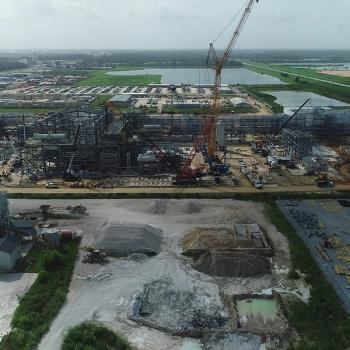
Variable-Speed, Integrally Geared Process Compressors
IS IT WISE TO CONFIGURE AN INTEGRALLY GEARED COMPRESSOR WITH VARIABLE-SPEED DRIVES?
Integrally geared compressors were first introduced for plant and instrument air service in the 1960s. The term “integrally geared compressor” (IGC) refers to a large driving gear (bull gear) which is coupled to a driver. The bull gear and up to six driven pinions are located in a suitable gear case. Pinion ends protrude through the gear case and impellers are fitted at the end of each pinion. In turn, each impeller is surrounded by its own flanged-on compressor housing (Figure).
Tens of thousands of integrally geared compressors are in successful operation throughout the world and their application range has been extended to cover about one hundred different process gases. Books and articles discuss advances and answer virtually all compressor- related questions.
Integrally geared compressors are centrifugal compressors; they belong in the family of dynamic compression equipment. However, their predecessor in the field of process gas machines is the traditional multi-stage centrifugal compressor. These traditional process gas machines are often driven by a variable speed driver.
This leads to questions on the variable speed capability of integrally geared machines and brings up general comparisons of single-shaft, multi-impeller technology versus integrally geared, speed-optimized technology.
To be clear, integrally geared technology allows speed optimization by simply designing and incorporating different impeller diameters to fit on the pinions driven by the central or bull gear. The different impellers (each called a stage) are typically three-dimensional, semi-open style.
Up to six pinions can be driven by the bull gear and impellers can be fitted to each end of a particular pinion. Because each pinion can have a different number of teeth compared to the number of teeth on another pinion, up to six different driven speeds can be accommodated in an integrally geared process gas compressor.
Impellers are designed and then machined on multi-axis machines to optimize blade contours, angles of twist, blade overlap, number of blades, and so on. One can, by design, optimize the efficiency of any of the 3-to-12 impellers. The various impellers are usually attached two per pinion. A wide range of impeller attachment methods is feasible and replacement and upgrading is relatively simple.
A single bull gear engages several pinions and each pinion can have a number of teeth that differs from the number of teeth in the other pinions. Therefore, up to six impeller speeds can be found in a single modern IGC compressor. Accordingly, the overall arrangement of integrally geared air and process gas compressors allows the use of the most efficient impeller for each of the up to six speeds and up to 12 compression stages that can be accommodated in modern IGCs.
Figure: Semi-open impellers are attached two per pinion; a bull gear engages up to 6 pinions (= 12 stages) in modern integrally geared compressors. Two pinions are shown here (Source: Cameron Compression, Buffalo, NY)[/caption]
As mentioned earlier, the bull gear is coupled to a driver — typically an alternating current (AC) electric motor whose speed is linked to the frequency of the power grid. Constant input speeds derived from 2- or 4-pole electric motors in 50/60 cps power systems are nominally 3,000 and 3,600 rpm, or 1,500 and 1,800 rpm. But these are constant input speeds, and questions on the availability of variable speed inputs are sometimes raised.
There are, however, areas of concern if one were to configure integrally geared compressor to be driven with variable speed drives (VFDs). Variable input speeds could conceivably create an infinite number of different lateral and torsional critical speeds. Aside from perceiving neither need nor incentive, applying VFDs on a compressor with many resonant frequencies is not for the faint-hearted. There would likely be an infinite number of critical speeds.
While a fixed input speed can be handled and undesirable frequencies avoided by design, the same is not true at VFD speeds. With infinitely variable input speeds there would be an infinite number of torsionals and their harmonics. Also, each free-standing impeller blade resonates at a particular frequency and these frequencies could be excited if VFDs were used.
Surface Treatments
Many integrally geared process gas compressors with steel impellers would probably benefit from a unique diffusion-conversion based technology. Turbocam Corporation’s “TX1” is a treatment that works through both diffusion and crystal lattice transformation. It imparts extremely high hardness and wear resistance (
By altering the crystalline lattice of the steel surface, TX1 eliminates wear at the nano level. Unlike coatings, there is no measurable dimensional change. Also, the spalling tendencies observed in certain coatings are nonexistent with diffusionconversion treated impellers. When an abrasive particle or opposing surface strikes TX1-treated steels, the wear energy is adsorbed and dissipated throughout the surrounding steel or steel alloy.
The diffusion-conversion treatment is available in aftermarket impellers from process developers. The same company is a supplier to several IGC manufacturers but, quite obviously, does not wish to compete with them. However, if your impellers are made by another entity you might give the matter more thought. In any event, diffusionconversion merits inclusion in many procurement specifications for steel impellers in virtually all types of fluid machinery. Next time a machinery owner opens up a machine for turnaround examination or similar work, examine its wear performance.
Written by: Heinz P. Bloch, an author over 600 publications, among them 18 books on practical machinery management, failure analysis, failure avoidance, compressors, steam turbines, pumps, oil-mist lubrication and practical lubrication for industry. He holds BS and MS degrees in mechanical engineering. For more information, heinzpbloch@gmail.com
Newsletter
Power your knowledge with the latest in turbine technology, engineering advances, and energy solutions—subscribe to Turbomachinery International today.




